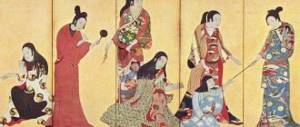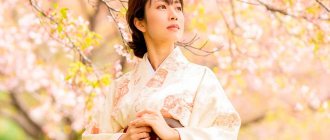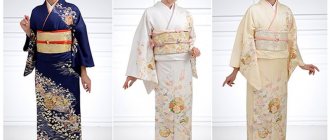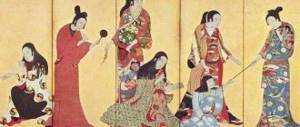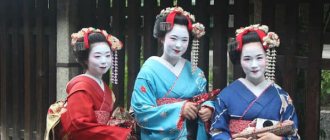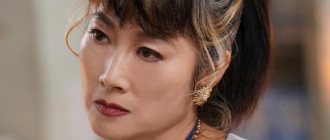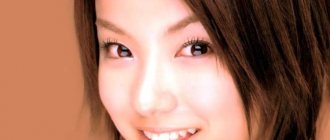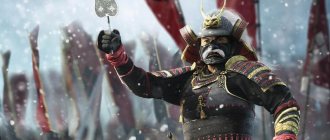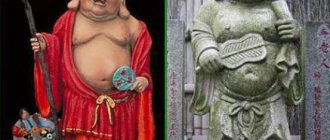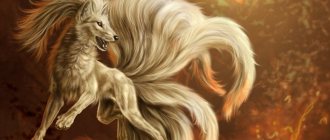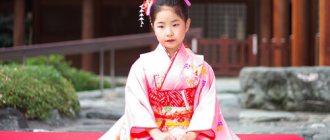Author: Varvara Lyutova
03 January 2021 11:20
Community: Facts
Tags: stories kimono fashion clothes where it came from changes in history styles evolution
8958
9
For centuries, style and fashion in Japan have been defined by one item: the kimono. It was not just a piece of clothing - it was a symbol of an entire culture, carrying symbolic meaning and embodying much more than what can be seen. Today we will try to trace the evolution of the kimono, starting from the 8th century AD, and evaluate its role in modern Japanese culture.
0
Source:
See all photos in the gallery
Character traits
Japanese kimonos are worn by both sexes and even children. The cut of this clothing is special. The model is created by applying geometric lines in the form of the letter T. It is not customary to fit it to a specific figure. We are talking not only about the width of the product, but also about its length. Accordingly, you can only order something with a strictly defined cut.
Info! Essentially, a kimano is a Japanese robe made of silk fabric. This is a long wrap dress with fairly wide sleeves, equipped with a wide belt and a bow in the back. The men's product is significantly narrower than the women's product, and is tied as close to the hips as possible.
The Japanese kimono creates an accent only in the area of the waist and shoulders. The figure in it is hidden, and existing imperfections are hidden. When putting on such clothing, it is adjusted to the wearer by creating characteristic folds. This design is fixed with the help of an obi belt .
When cutting clothes, a single piece of fabric is used. Its width is 40 cm , and its length varies between 9 – 12 m . Four stripes are created from this matter. Two of them are used to cover the body, and the other two are used to create sleeves. An overhead and main collar is additionally created from small strips. Also, a couple of narrow parts are used to decorate the front edges. All these elements have a rectangular shape. There are no curves on them.
The Japanese robe wraps to the right side. Due to this, the left part is always located on top, and the right one is inside, as close as possible to the body. The sleeves are visually similar to the bag. In men's models they are sewn in. In female versions, a hole called furitsyakuchi .
Sleeve length may vary. For example, in girls who have not yet married, as well as in future geishas, they reach a meter. Children's models look a little simpler. Due to this, there are no difficulties with putting on the product. This outfit resembles a quilted version of a robe and is made in brighter colors than adult models.
Traditional materials for creating clothes are satin and silk. Painting on fabric is usually done by hand. The patterns, their location, as well as the color of the item of clothing directly depend on the gender and age of the person, as well as his social status and the occasion for which the outfit is worn. The connection between the print and the season is also noted. For example, in spring, clothes are decorated with sakura flowers, and in winter, bamboo and pine trees are depicted on them.
Children's
Women's
Male
Color
0
Source:
The color of the kimono also has symbolic meaning, as do the pigments chosen for dyeing. “Colors embody the spirit of the plants from which they are taken,” explain the Victoria and Albert Museum. “The same applies to their medicinal properties, which are believed to be transferred to the tissue. For example, blue, obtained from the indigofera plant, is believed to repel snakes and insects.”
Existing types
Finding a Japanese kimono that meets all the requirements is quite problematic. This is due to the fact that there are quite a lot of varieties of such clothing. Among the main types, the following can be distinguished:
- Homongs. Used at receptions and official events. Drawings are present in the sleeves and shoulders. This outfit can be worn by unmarried women, as well as married ladies;
- Iromuji. The color of the robe is monochromatic. It is appropriate to have a woven jacquard pattern called rinzu on the fabric. Similar wardrobe items are intended for the tea ceremony;
- tomesode. It is considered one of the most official options. This Japanese kimono is worn by married ladies. The pattern on them is located below the waistline, as well as along the hem. One of the varieties of such clothing is kurotomesode. This is a black robe with the family coat of arms on it. The mothers of the bride and groom wear it at the wedding;
- furisode. A robe for formal events with sleeves about a meter long. Designed for unmarried Japanese women. Bridesmaids, as well as geisha students, wear it;
- comon. Japanese kimono with a small print, which you can wear to a restaurant or for a walk;
- edo komon. Robe with polka dot print. Previously, such an outfit was in demand among samurai. Now they began to put coats of arms on clothes. It is appropriate for receptions;
- mofuku. Considered a mourning model, it is made in a black palette. The relatives of the deceased wear such clothes. All other people who are present at the ceremony can wear iromuji. The main thing is that the presence of black parts is noted on the item of clothing;
- Susohiki. The outfit is equipped with a long train. This type of clothing is used by geishas. Traditional dances are performed there;
- yukata. Summer model, sewn with cotton or linen fabric. Considered unofficial.
These are just the main types of traditional Japanese outfits. In fact, there are many more of them.
Content and style
The main part of the kimono is traditionally made of silk with dyed yarn embroidery. Over the centuries, a variety of techniques have been used to create patterns on kimonos, from shibori (traditional Japanese dyeing) to embroidery and even printing. Early examples were hand-painted or stenciled.
Patterns and colors were often an indicator of social status . Over the past century, kimono style has changed greatly, evolving as world fashion changes. Patterns are still sometimes an indicator of social status, but not so obviously.
There are also a few common patterns and colors that have not changed over the years:
Cranes
Although the crane is a living creature, it is often found in mythology and is believed to live for thousands of years in the land of the immortals, so it is associated with longevity and good fortune.
Blooming cherry
Although this kimono can be worn all year round, cherry blossoms or sakura are associated with spring and a good harvest.
You can read more about sakura and its meaning here.
Mandarin duck
These ducks are considered a symbol of love in Japan, and their images can often be seen on wedding dresses.
Chrysanthemums
A highly revered flower in Japan, it is also a national symbol, meaning longevity and good luck during the harvest season. However, white chrysanthemum is associated with funerals and death, so you need to be careful not to get into an awkward situation!
Purple
The color purple symbolizes immortal love. This meaning comes from the plant that is used to create purple dye, as it has long roots and takes root well in the ground, suggesting permanence.
Red color
This color is popular among young people and in itself symbolizes glamor and charm.
Motifs of folk tales
It's not so much a specific pattern as it is a general theme. Kimonos that want to give a more sophisticated look are often depicted with landscapes or scenes from folklore.
Classification based on purpose
Info! Women's and men's Japanese kimonos differ significantly not only in cut, but also in colors, symbols and additional elements. Men wear more discreet robes. They can be made in brown, green, black and blue. When sewing, the material used is matte, there is no shine on it. The print is printed and quite small.
On the formal attire of men, the presence of five kamon is obligatory. Costumes with three coats of arms are considered less official. Often the addition is a wide skirt or pants called hakama. Men can also wear a haori jacket over their robe. Apart from shoes, the suit includes only five wardrobe items.
Women's models usually consist of twelve elements. True, modern Japanese women wear such a multi-layered suit only on special occasions. Women wear such attire at important official events and at wedding celebrations. For everyday wear, it is enough to wear just a couple of layers of clothing or wear a Japanese kimono, equipped with an additional false collar.
In the case of women's attire, color is of particular importance. The most formal is the black version with a print below the waistline and in the sleeve area. Geisha can use bright colors, which are equipped with a scarlet lining. Unmarried ladies are allowed to wear blue, peach and pink robes, which are completely embroidered with flowers. For everyday life, choose a Japanese kimono in discreet shades. For example, green, brown or beige options. A small print is appropriate on them.
Children's dressing gowns have a simpler cut. They are multi-colored and are often altered from adult clothing. As a rule, the products are quilted. Their design is not complicated. When a child grows up, clothes are sewn for him according to the same principle as for adults, but in brighter colors. Such dresses are worn only on special occasions.
History of Japanese kimono
Already from the third century, there were records of clothing made from a single piece of cloth, worn by both men and women. This time is considered the starting point for the Japanese kimono as we know it today. For women, it all started with kantoi - sleeveless clothing, which then evolved into kosode - a robe with small sleeves.
Much at that time was still created under the influence of Chinese culture, and such clothing became more characteristic of Japan, so it found its place in every era. The length of the sleeves, the number of layers of fabric changed and, in general, the kimono became more comfortable over time.
The difference between men's and women's clothing styles became more apparent as society changed during the Edo period (1603-1868). Men's clothing, and kimonos in particular, remained very practical, so colors were often more muted. Women, on the other hand, had freedom to choose colors and styles because there was not as much need for practicality.
Ultimately, kosode finally took on the characteristics of a kimono during the Meiji era (1868-1912), and the changes were more in terms of patterns and style of wear than any major changes in the shape of the garment itself.
The kimono is usually most associated with geisha, who wear the garment elegantly and professionally while entertaining their guests. Read more about geishas in our article.
Additional costume elements
In addition to the robe, the costume includes many other details. The most popular of them are worth considering in more detail:
- sasoeke and hadajuban. Wide trousers and a thin shirt, which are used in the form of a kind of underwear;
- Juban. A long shirt with a cut reminiscent of a Japanese kimono. It is customary to wear it under the main item of clothing to avoid sweat getting on the outfit;
- hakama. Wide pleated pants or skirt;
- haori. A special model of jacket that is worn over a robe. Due to this, the image becomes more formal. The structure is secured with a cord called haori-himo;
- kanzashi. A special type of handmade jewelry. Often the motifs of pins echo the prints on the main item of clothing;
- tabi. Special socks with the big toe separated. This ensures maximum comfort when wearing shoes;
- zori. Sandals made of fabric or leather. Visually similar to slates;
- geta. Shoes made of wood. As a rule, such sandals are worn in an ensemble with a yukata;
- Varazdi. Sandals made from straw. Priests wear such shoes in temples;
- obi. A wide belt that complements the main outfit;
- okobo. High-soled shoes. It is possible to walk in it only in small steps. Otherwise, the girl may fall.
Japanese kimono is more than just clothing. This is part of Japanese culture, personifying the traditions of this people. Such costumes come in a wide variety and are selected taking into account the occasion for which they are used. Despite the fact that they appeared many centuries ago, such wardrobe items remain in demand to this day.
Modern images
Photos of models
Read: 2810Share the post with your friends
